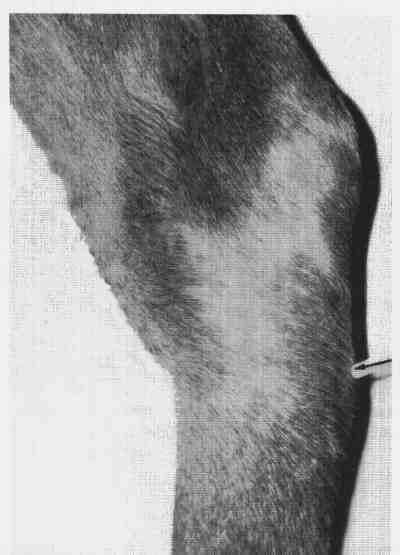Curb and Curby Hocks in Horses
by Robert N. Oglesby DVM
Introduction
Introduction
»
Examination
»
Long Plantar Desmitis (LPD)
»
Surrounding Soft Tissue Swelling (SSTS)
»
Superficial Digital Flexor Tendonitis (SDFT)
»
Deep Digital Flexor Tendonitis (DDFT)
»
More Info & Discussions
The traditional meaning of curb is a swelling or enlargement of the back (plantar) aspect of the hind leg just starting at the bottom of the hock (see image below). This is best seen when viewing the horse from the side and gives a smooth convex outline where the horse is normally straight in this region. It may or may not be accompanied with lameness. The term "curby" is heard, which is often a horse with sickle-hock conformation that cause a convex appearance to this region. Curby conformation can predispose to curb but horses with normal conformation develop curb also.
In the past the enlargement was diagnosed as a inflammation and thickening of the long plantar ligament which runs down the back of the hock. However, the distal flexor tendons traverse this area and lie over the plantar ligament. All of this overlies the bones in the back of this region of the hock. Also the proximal splint bones, and their associated ligaments, lie to each side of this region with the proximal origin of the suspensory and its associated check ligament between them. Not surprisingly careful radiographic and ultrasound examination of a large number of curbs finds this is really a complex of different soft tissue injuries and bony enlargements of this region of the hock.
So curb is not a diagnosis but a description of a particular swelling with several causes and with other diseases resembling it. Only careful examination will reveal the true disease present and the treatment and prognosis will be based on the particular disease present and the severity of the lesions. This article deals with correctly identifying the appearance of curb, correctly diagnosing the cause, and the treatment and prognosis of each.
Examination
Introduction
»
Examination
»
Long Plantar Desmitis (LPD)
»
Surrounding Soft Tissue Swelling (SSTS)
»
Superficial Digital Flexor Tendonitis (SDFT)
»
Deep Digital Flexor Tendonitis (DDFT)
»
More Info & Discussions

Examination should begin with a thorough understanding of the
anatomy of this region followed by a careful
evaluation of lameness. The swelling should be viewed from all perspectives and palpation may allow for a preliminary identification of the structure involved and ruling out conditions that resemble curb. These include:
- Swelling of the calcaneal bursa (capped hock which is further up the back of the hock)
- Swelling of the sheath surrounding the deep digital flexor tendon (more medial aspect of the back of the hock)
- Bony enlargements of the proximal splints
However there are several conditions, including diseases of the proximal lateral splint bones that can be easily be confused with diseases of this region. When lameness is present consider also other diseases including degenerative joint disease of the hock. Because of the many diseases of this region, and their variable presentation, ultrasound and radiographic evaluation is essential to accurately diagnose the lameness and severity of the condition. The ultrasound is particularly important to define the tissues involved and type and severity of the lesions.
In one study of seventy-three hores with curb were examined using ultrasound:
- 34% (25) had a combination of fluid in the surrounding soft tissues and long plantar ligament desmitis.
- 30% (22) had chronically thickened tissues surrounding the SDFT, DDFT, and/or plantar ligament without signs of tendinitis or desmitis.
- 25% (18) had a combination of fluid, edema and/or hemorrhage, and a superficial digital tendinitis.
- 6 (8%) had fluid accumulation, edema and/or hemorrhage, alone in the surrounding soft tissues
- 2 (3%) had purulent exudate (infection)
Reviewing the history of these horses race horses, especially those with sickle hocks, were most often effected and their lesions tended to be inflammation of the ligaments and tendons. Horses from other sports were only occasionally effected and most often had swellings of the soft tissues surrounding the tendons and plantar ligament. Trauma to this region is common in all horses, especially in horses that kick their stall walls. Following a careful examination a diagnosis of the structures and severity of the lesions can be made and treatment and prognosis formulated.
Long Plantar Desmitis (LPD)
Introduction
»
Examination
»
Long Plantar Desmitis (LPD)
»
Surrounding Soft Tissue Swelling (SSTS)
»
Superficial Digital Flexor Tendonitis (SDFT)
»
Deep Digital Flexor Tendonitis (DDFT)
»
More Info & Discussions
To read more on this topic become a member of
Horseadvice.com! Your membership gets you instant access to this and over 600 equine articles on our site. Other benefits of your membership include participation in our discussion boards and access to our one button PubMed search tool for each topic.
Horseadvice.com educates you to be a more knowledgeable horse owner which leads to healthier horses and save you money, we guarantee it. Come Join Us!
 Examination should begin with a thorough understanding of the anatomy of this region followed by a careful evaluation of lameness. The swelling should be viewed from all perspectives and palpation may allow for a preliminary identification of the structure involved and ruling out conditions that resemble curb. These include:
Examination should begin with a thorough understanding of the anatomy of this region followed by a careful evaluation of lameness. The swelling should be viewed from all perspectives and palpation may allow for a preliminary identification of the structure involved and ruling out conditions that resemble curb. These include: